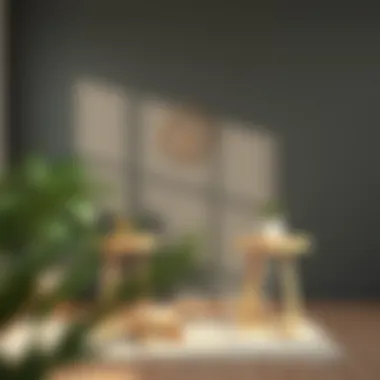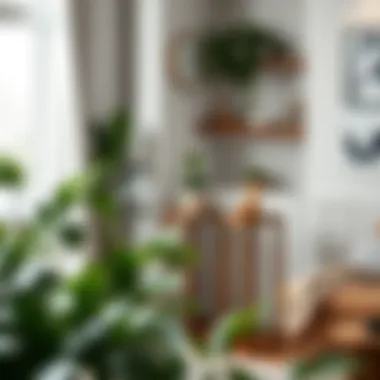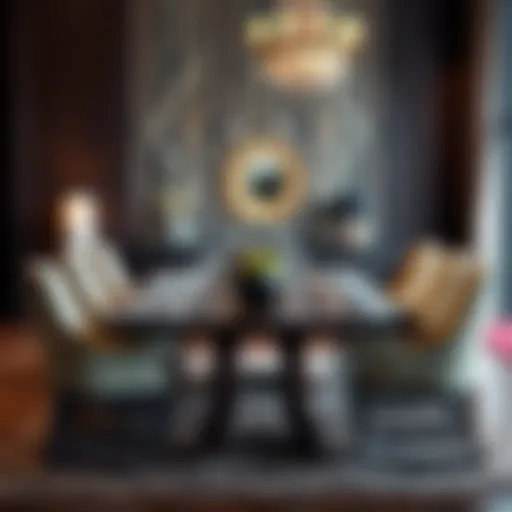The Versatile Appeal of Narrow Plant Stand Tables


Intro
Narrow plant stand tables are becoming more than just a piece of furniture – they have evolved into vital components of our indoor living spaces. Their unique design not only serves a functional purpose but also adds a touch of character to any room. Homeowners, designers, and anyone passionate about aesthetics can find these tables instrumental in achieving both style and practicality.
These stands are often overlooked in the realm of home decor, yet their versatility allows for placement in various spaces, making them perfect for anyone looking to spruce up an area. Whether in a cozy corner, near a window, or even as a stand for decorative items, narrow plant tables can transform visuals without hogging valuable floor space.
Throughout this exploration, we will dive into styles, materials, maintenance tips, and placement strategies. This comprehensive guide aims to enhance your understanding and integration of narrow plant stand tables into your decor scheme.
Furniture Styles and Trends
Modern vs. Traditional: Understanding the Aesthetics
When shopping for a narrow plant stand table, understanding the spectrum between modern and traditional aesthetics can significantly influence your choice.
Modern designs typically feature clean lines, minimalist structures, and innovative materials like metal, glass, or engineered wood. They often embody simplicity and functionality. Think of stark white finishes or bold black frames that allow plants to take center stage. These stands add a contemporary flair, resonating with urban homes and artful spaces.
On the other hand, traditional styles boast intricate carvings and rich wood finishes that harken back to classic design. With a focus on elegance, these tables may use varieties such as oak or mahogany, offering warmth and depth. They typically evoke feelings of nostalgia and comfort, making them perfect for more traditional homes or vintage-inspired decor.
Color and Material Trends: What's In and What's Out
In today’s design world, color and material matter immensely. Choosing the right shade for your narrow plant stand table can enhance or detract from your overall decor. Natural wood tones are always in style due to their organic appeal. Green hues, reminiscent of the plants they support, are increasingly popular for earthy vibes. Contrast that with bright pastels for a playful touch or deep jewel tones for drama.
As for materials, the trend leans towards the incorporation of eco-friendly options. Bamboo and reclaimed wood are priorities for many consumers engaging in sustainable living. Similarly, metal accents have become a go-to for modern designs, bringing an edgy feel to an otherwise cozy setup. However, materials that have seen less enthusiasm often include overly glossy finishes that mask textures – they tend to feel less inviting.
"Functional decor pieces, such as narrow plant stand tables, have gained momentum due to their dual benefits of utility and style."
Furniture Care and Maintenance
Tips for Prolonging the Life of Your Furniture
Once you’ve invested in a beautiful narrow plant stand table, keeping it in prime condition is vital. Here are some tips to extend its life:
- Regular Cleaning: Use a damp cloth and mild soap for cleaning. Avoid harsh chemicals that may damage the finish.
- Avoid Direct Sunlight: Prolonged exposure to sunlight can warp or fade materials, so take care when placing your table.
- Use Coasters: If placing pots directly on the table, coasters can protect surfaces from moisture and stains.
DIY Repair Hacks for Common Furniture Issues
Even with the best care, furniture faces wear and tear over time. Learning a few hack can go a long way:
- Wood Scratches: Use a mix of crushed walnuts and olive oil to fill and disguise scratches on wooden surfaces.
- Wobbly Legs: Tightening screws or adding small adhesive pads can stabilize a shaky table.
- Stains: For tough stains on metal or plastic, baking soda mixed with water serves as an effective gentle scrub.
By understanding styles and proper care for narrow plant stand tables, anyone can integrate these pieces into their homes effectively. With many trends emerging, ensuring that you maintain their aesthetic appeal will only add to your living spaces, leading to comforting and inviting atmospheres. For further reading, visit Wikipedia or Britannica.
Exploring the various facets of narrow plant stand tables, one can truly appreciate their ability to blend functionality with beauty.
Prolusion to Narrow Plant Stand Tables
In the realm of interior design, narrow plant stand tables have found their niche, garnering attention for their blend of function and fashion. They serve not just as simple holders for plants but as dynamic elements that breathe life into various spaces. These tables can transform a drab corner into a flourishing oasis of greenery, subtly contributing to the home’s aesthetic.
Defining Narrow Plant Stand Tables
Narrow plant stand tables are typically minimalist structures designed to accommodate plants while occupying minimal floor space. More than just a display piece, these tables might vary in height and design, catering to different plant types and interior settings. Generally, they possess a slender form; this ensures that homeowners can squeeze them into tight spots — think of that little area between a sofa and the window or beside a hallway.
We often find these tables crafted from various materials, enabling them to blend seamlessly with diverse interior styles. Whether it's a sleek metal frame or rustic wood, the choice of material plays a crucial role in the overall vibe they convey.
Historical Context and Evolution
The concept of plant stands has been around for centuries, but the narrow variant evolved to meet the demands of modern homes. Historically, plant stands were bulky and designed primarily for function rather than elegance. With the rise of houseplant popularity in the late 19th century, these stands began to evolve. People sought displays that lifted plants from the ground, providing better visibility and emphasizing their beauty.
During the mid-20th century, as architecture became more open and spaces more compact, the need for furniture that accommodated plants without occupying too much room took center stage. Designers started developing narrower models that fit the ever-shrinking dimensions typical of urban living. Now, we see narrow plant stands that meld effortlessly with contemporary decor, and their designs are more artistic than utility-driven.
In summary, narrow plant stand tables are not simply about holding plants; they symbolize a marriage of form and function, a celebration of green aesthetics that has evolved to fit our changing spaces. Their importance lies not only in their practicality but also in their role in creating inviting, lived-in atmospheres.
Design Variations
Design variations of narrow plant stand tables play a pivotal role in how these pieces resonate within a home or commercial space. It’s not just about functionality; it’s about how they fit into the aesthetic narrative of a room. Variations in design allow homeowners and designers to choose styles that serve not only as plant holders but also as decorative statements, enhancing the overall character and mood of the environment. By understanding the diverse designs available, one can effectively pair these tables with their décor, ensuring harmony and visual appeal throughout the space.
Modern Aesthetic
Modern narrow plant stands often emphasize clean lines and geometric shapes, reflecting a minimalist philosophy. The use of materials such as glass, polished metal, and light wood tends to dominate this style, providing a fresh and airy feel. One distinguishing feature of modern designs is their ability to not just complement plants but to highlight them effectively, often placing the flora at the center stage. For example, a sleek, white, powder-coated metal stand can create a striking contrast with vibrant green foliage, drawing the eye effortlessly.


Additionally, modern designs often incorporate multifunctionality, integrating shelving or storage space, making them not only a spot for plants but also a practical solution for organization. In many contemporary homes, where space is at a premium, a narrow plant stand with dual purposes can be a game changer. These pieces allow homeowners to keep their spaces tidy and aesthetically pleasing without cramping their style.
Rustic and Vintage Influences
On the flip side, narrow plant stands that embrace rustic and vintage influences exude a warmth that resonates with many homeowners looking for charm and character. Made typically from reclaimed wood or wrought iron, these stands echo historical sensibilities that invite nostalgia. The imperfections in a weathered wood finish or a patina on wrought metal tell a story, adding depth to any environment.
In settings like a cozy living room or a sun-drenched kitchen, these stands often serve as perfect locales for houseplants, contributing to the ambiance. Imagine a beautifully aged wooden stand in a countryside setting, adorned with trailing vines or blooming herbs, adding a sense of life to the atmosphere. By opting for rustic styles, you create spaces that feel lived-in and inviting, where every item, including your plant stand, feels like a part of an ongoing story.
Minimalist Approaches
When it comes to minimalist approaches, the beauty lies in simplicity and function. Degree in minimalism often manifest through narrow plant stands that feature unadorned designs—think sleek frames with no extravagant detailing. These stands tend to be utilitarian but highly stylized, embodying the 'less is more' ethos. They provide the function without overcrowding the visual field, allowing plants to shine brightly without distractions.
For example, a simple black metal frame combined with a glass top works wonders in a modern setting, where the focus remains firmly on the plant itself. Such designs are often perfect for small apartments or urban environments where simplicity can lead to a more spacious feeling without compromising on style. Additionally, these minimalist stands can be easily integrated into various décor styles, making them versatile and appealing in many contexts—including mid-century, contemporary, or even eclectic interiors.
Understanding these design variations opens a world of possibilities for using narrow plant stands. Each style offers unique advantages and touches, allowing for personal expression in decor while showcasing the natural beauty of plants.
Materials and Construction
When it comes to narrow plant stand tables, the materials and construction methods play a pivotal role in defining their appeal and longevity. Homeowners and designers need to consider various aspects such as aesthetics, durability, and maintenance requirements when selecting these tables. The choice of material not only influences the overall look but also contributes to the functionality of the stand. In this section, we will delve into three predominant materials: wood, metal, and glass/stone, shedding light on their unique properties and advantages.
Wood: Natural Beauty and Warmth
Wood has a timeless appeal that many find irresistible. Its warmth adds an organic charm that can easily enhance any room's ambiance. Using materials like oak or walnut provides sturdy support for plants while offering a rich visual texture. Each piece of wood tells its own story through the unique grain patterns, making every table distinct.
Here are a few critical benefits of wooden plant stands:
- Aesthetic versatility: Wood can be finished in various stains and paints, allowing for customization to match existing decor.
- Sustainability: When sourced responsibly, wooden stands can be eco-friendly, aligning with a growing trend towards sustainable living.
- Sturdiness: High-quality hardwood provides strength, making it capable of holding hefty pots without wobbling.
However, maintaining wooden tables requires some extra care. Regular oiling and protecting from moisture will keep them looking their best for years.
Metal: Industrial Edge and Durability
Metal plant stands are synonymous with modernity. Stainless steel, wrought iron, or aluminum frames not only bring an industrial flair but also ensure reliability. These materials resist weather elements when used outdoors and withstand the test of time indoors.
Key features of metal plant stands include:
- Durability: Metal is impervious to common wear and tear, making it an excellent option for bustling households or outdoor use.
- Lightweight options: Aluminum stands, for instance, offer portability without sacrificing strength.
- Low maintenance: A quick wipe-down is typically all that’s needed to keep metal looking good as new.
While these stands are robust, it's essential to avoid excessive rusting by treating them properly, especially if exposed to moisture.
Glass and Stone: A Contemporary Touch
Glass and stone adds a layer of sophistication to narrow plant stands, making them suitable for upscale environments. Glass offers transparency that can make spaces appear larger, while stone brings an earthy, solid feel that connects indoors with nature. These materials are often used in contemporary designs, making them favorites in modern and minimalist decor.
Consider the following aspects of glass and stone plant stands:
- Visual appeal: The reflective quality of glass can beautifully highlight the plants it supports, while stone provides unmatched solidity.
- Diverse textures: From smooth glass finishes to textured stone surfaces, there’s a wide range of aesthetics achievable.
- Durability with care: Glass can chip or break if mishandled, and certain stones might require sealing to prevent staining.
It's critical to select high-quality glass and stone products to ensure safety and longevity, especially when used to display cherished plant specimens.
Functional Benefits
Narrow plant stand tables have emerged as a beloved choice in many homes due to their practicality intertwined with charm. They effortlessly blend function with beauty by addressing several essential needs when it comes to enhancing our living spaces. Here, we will explore the core functional benefits that narrow plant stands provide, highlighting their significance in both aesthetic and practical applications.
Space-Saving Solutions
In today’s fast-paced world, space is often a luxury. Many homeowners face the challenge of making the most out of limited square footage. Narrow plant stands come into play as brilliant space-savers, fitting snugly into tight corners or narrow hallways, unlike bulkier furniture pieces. Their vertical orientation allows for efficient use of vertical space, making them ideal for apartments or smaller homes.
"The beauty of these stands lies in their ability to utilize vertical space, fitting seamlessly even in the coziest of corners."
An example can be seen in a small studio apartment where every inch counts. A tall, slim plant stand can raise beloved greenery to eye level while doubling as a decorative feature. This type of setup not only maximizes floor space but also adds depth to the visual composition of a room. Here are some of the specific advantages of narrow plant stands in relation to space:
- Compact Design: Their slender profile allows them to occupy minimal floor area.
- Vertical Growth: They offer structures for plants that grow upward, which makes them ideal for those with limited horizontal space.
- Multi-functionality: Some stands can also function as plant holders and displays, adding to their utility.
Enhancing Indoor Greenery
Incorporating plants into indoor environments is beneficial for both aesthetics and air quality. Narrow plant stand tables provide a versatile platform for showcasing a variety of plants, including florals, succulents, and trailing vines. They allow homeowners to create tailored green spaces, transforming an ordinary living room into a lush paradise.
The positioning of stands can influence how light permeates the room, allowing plants to bask in natural sunlight. For instance, a narrow stand positioned by a window can showcase favorite plants that thrive in full sun while keeping them off delicate tabletops. Additionally, varying heights can create visual intrigue and depth, making any room feel more dynamic.


- Health Benefits: Indoor plants naturally improve air quality by filtering toxins.
- Emotional Wellbeing: A green environment is known to reduce stress and enhance mood, turning spaces into personal oases.
Organizational Aspects
One of the often-overlooked benefits of narrow plant stand tables is their contribution to organization. They create designated areas for plants, which helps prevent clutter and adds a degree of orderliness. This is particularly useful for those who might struggle with maintaining cohesion in their home's decor.
By using narrow stands, you can minimize chaotic arrangements of pots on various surfaces, creating a streamlined, polished look. Here are some organizational considerations associated with these stands:
- Grouping Plants: They offer an effective way to group plants based on care needs, making it easier to manage watering and maintenance routines.
- Accessory Integration: Alongside plants, many stands can accommodate decorative objects, such as books or small art pieces, creating a coherent aesthetic.
- Visibility: The elevated platform makes it easier to assess the condition of plants at a glance, reducing the chances of neglect.
In summary, the functional benefits of narrow plant stand tables make them a staple in modern decor. They provide solutions for space efficiency, enhance the indoor greenery experience, and help maintain organization within our homes. Whether you're an avid plant lover or just want to add some life to your space, these stands represent a thoughtful union of function and form.
Decorative Uses
Narrow plant stand tables offer more than just a space for greenery; they act as versatile design elements that can significantly enhance the interior decor of a home. Their ability to blend functionality with aesthetics makes them a preferred choice for homeowners looking to create inviting spaces. From adding height to a room to creating focal points, these tables serve many decorative purposes that extend far beyond being mere plant holders.
Accent Tables in Various Rooms
One of the most compelling aspects of narrow plant stand tables lies in their adaptability across different rooms. In the living room, for example, these tables can be placed next to sofas or armchairs, acting as stylish side tables. They can hold a cup of coffee or a few magazines, immediately providing both utility and flair. In bedrooms, a narrow stand can serve as a charming nightstand, offering just enough space for a lamp and a few personal items without overwhelming the room’s layout.
In dining areas, these tables can double as attractive display areas for tableware or seasonal decor. With strategic placement, they can accentuate the aesthetics of the room without taking up valuable floor space.
Pairing with Other Furniture
To optimize the visual appeal of narrow plant stand tables, thoughtful pairing with other furniture pieces is crucial. For instance, placing a sleek metal stand next to a plush, upholstered sofa creates a delightful contrast between textures. On the other hand, a wooden stand might serve well in a rustic setting, matched with similarly styled furniture to maintain consistency in design.
When positioning these tables, consider the height and proportion of adjacent items. Grouping tables with side chairs or ottomans not only creates a cohesive look but enhances the functional aspects of the space. Don’t shy away from experimenting! A stand can offer complementary colors or materials that reflect or contrast with larger pieces, breathing life into the room and enhancing the overall aesthetic.
Styling with Plants and Accessories
Styling narrow plant stand tables is where creativity truly shines. While plants are the standout feature, the table can serve to display decorative accessories in a way that brings balance and harmony to a room. Start with a single, striking plant at the center – think of something like a tall snake plant or a bushy pothos. From there, you can branch out (pun intended) with smaller succulents or decorative stones in varied heights and colors to create visual interest.
Next, consider incorporating other accessories, like art pieces, books, or even candles, but be cautious to avoid clutter. A well-styled table should feel curated rather than chaotic. Here are a few tips:
- Layering: Use books as a base and place a plant on top to create visual dimensions.
- Varying Heights: Pair a tall plant with shorter decorative items to avoid a flat look.
- Color Coordination: Ensure that the colors of pots and accessories complement the room, making the table a cohesive part of the decor.
"A well-placed narrow plant stand can transform an ordinary corner into an extraordinary design moment."
Placement Strategies
When it comes to narrow plant stand tables, placement is key. These unique pieces of furniture not only provide a home for your beloved plants but also serve practical purposes in enhancing the aesthetics of a space. Thinking about where to put these stands can turn a routine room into a well-thought-out environment. Understanding optimal locations in the home is crucial for effective design. Not every corner or flat surface can support a narrow plant table. Thus, considering factors such as light exposure, overall layout, and functionality can ensure that you make the most of these versatile tables.
Optimal Locations in the Home
Choosing the right spot in your home for a narrow plant stand entails more than just finding an available space. Here are some considerations that come into play:
- Natural Lighting: Place plant stands near windows for sunlight. Most greenery thrives on brightness. A table positioned to catch the morning sun can work wonders for that Monty pot or snake plant.
- Living Room Corners: In a living space, a stand can effectively utilize a corner that otherwise goes unnoticed. In fluently adding layers to your decor, consider pairing the plant with a book or a small lamp.
- Entryway Tables: Think about using a narrow stand in your entryway. It can provide a welcoming ambiance with a splash of green as you walk in the door.
- Bathroom Inspiration: Certain plants thrive in humid conditions. A narrow plant stand in your bathroom can not only hold suitable plants but also offer an unexpected touch to an otherwise functional area.
- Kitchen Accents: Herbs on a narrow plant stand by the window can keep the cooking space vibrant and fresh.
Balancing Functionality and Aesthetics
While it's tempting to think solely about fashion when choosing placement, it is vital to balance the practical and the prettiest. This balance creates harmony in your home. Here are some tips for achieving that:
- Personal Preference: Consider what look you'll enjoy over time. Select a spot that's convenient for watering and maintaining your plants while also appealing in terms of design.
- Multi-Functional Uses: Narrow stands often serve more than one purpose. If you can utilize one for both plant display and as a side table, you've struck gold.
- Avoid Overcrowding: Too many items in one area, especially in small spaces, can lead to a chaotic appearance. Aim for fewer yet well-placed stands that complement rather than clutter.
- Use of Color and Texture: Choose stands that complement your existing furniture. A wooden stand can balance sleek metal furnishings or vice versa.
"A well-placed plant stand does not just hold plants; it enhances the essence of an entire room."
By considering thoughtful placement strategies, you can bring out the best in narrow plant stand tables while ensuring that the essence of your living space shines through. As you put pencil to paper and draft your interior layout, remember that these tables not only provide room for your plants but are also avenues for creativity within your decor.
Maintenance and Care
Narrow plant stand tables are not just an addition to decor; they require a good dose of care and attention to keep them looking fresh and functional over time. Maintenance is crucial not only for preserving aesthetics but also for ensuring longevity. The right cleaning techniques and preventive measures can make all the difference in how these tables endure daily wear and tear.
Understanding how to maintain and care for these tables will help homeowners and design enthusiasts enjoy their benefits without running into issues that could compromise their appearance or functionality.
Cleaning and Upkeep Tips
Regular cleaning is paramount for any furniture, and narrow plant stands are no exception. Dust, moisture, and even marks from pots can accumulate, detracting from their intended beauty. Here are some tips for keeping your narrow plant stand in tip-top shape:
- Dust Regularly: Use a soft, dry cloth to wipe down surfaces. This prevents dust from settling and potentially damaging finishes.
- Use Appropriate Cleaners: Depending on the material, select suitable cleaning solutions. For instance, a mild soap solution works well for wooden stands, while metal ones can often be wiped clean with a damp cloth.
- Avoid Excessive Moisture: When watering plants, be careful to avoid spills on the table's surface. If moisture does accumulate, dry it off immediately to prevent staining or warping.
- Spot Clean: For marks or stains, a careful approach using a damp cloth with a bit of mild detergent can help. Test on a small area first to ensure no damage occurs.


Preventing Damage to Materials
It's essential to consider the materials that make up your narrow plant stand tables and how to protect them from potential harm. Each material has unique needs, and being conscious of these can prolong the life of the furniture. Here are some tips specifically for common materials:
- Wood: Ensure your wooden tables are sealed properly. This not only enhances their beauty but also creates a barrier against moisture and stains. Place coasters or trays underneath pots to minimize direct contact.
- Metal: While metal stands are generally sturdy, they can rust or tarnish if exposed to moisture. Keep these tables in dry areas and consider applying a rust-resistant spray periodically.
- Glass: Although stylish, glass surfaces require careful treatment. Avoid placing hot pots directly on glass, as this can scratch or weaken the surface. Additionally, a glass cleaner should be used for streak-free shine.
Remember: A little care goes a long way. Investing time in maintaining your narrow plant stand tables can save you money and heartache in the long run.
By incorporating these cleaning and care practices, you'll ensure that your narrow plant stand tables remain not only functional but also visually appealing in your home. Keeping them well-maintained enhances the overall ambiance of your space, making a statement about your commitment to detail in your decor.
Sustainable Practices
In a world where environmental consciousness is becoming increasingly critical, choosing sustainable practices in furniture design, particularly for narrow plant stand tables, is of utmost importance. These tables can be crafted in ways that not only accentuate your living space but also contribute positively to the environment. By selecting materials and practices that prioritize sustainability, homeowners and designers alike can ensure they’re not just beautifying their homes but also championing ecological responsibility.
Choosing Eco-Friendly Materials
When it comes to selecting eco-friendly materials for narrow plant stand tables, the options are diverse and compelling. Bamboo, for instance, is a prime candidate; it's a fast-growing grass that regenerates quickly without the need for harmful pesticides. As a result, bamboo is not only sturdy and light but also a sustainable alternative to traditional timber.
Recycled wood also plays a vital role. Using reclaimed wood not only gives tables unique character filled with history but also reduces the demand for new lumber. This practice helps preserve forests and reduces waste in landfills. Moreover, manufacturers are now exploring innovative options like recycled plastic or biodegradable composites that hold great promise for green design.
As consumers, being mindful of certifications can aid in making eco-conscious choices. Look for labels such as Forest Stewardship Council (FSC) certified wood or products made from sustainably sourced materials.
"Every small choice in favor of sustainability can lead to remarkable changes in our environment."
Recycling and Upcycling Ideas
Recycling and upcycling existing materials can provide a rich avenue for creativity while promoting eco-friendly practices. Turning old furniture pieces into narrow plant stands is not only a fun project but also helps keep waste to a minimum. For instance, repurposing an old ladder as a multi-tiered plant stand creates an eye-catching statement piece and gives new life to something that might have been discarded.
Another idea is to use old crates or pallets, which can be transformed into charming plant stands. A little sanding and some paint can work wonders, making it a delightful weekend project. Here are some upscline ideas:
- Old Suitcases or Trunks: Stack them creatively to create a whimsical plant display.
- Window Frames: Utilize old window frames to create a rustic display for smaller plants.
- Wine Crates: Turn them into tiered stands that not only display plants but can also double as storage.
- Tin Cans: After giving them a solid coat of paint, these can be hung on walls for a vertical garden effect.
In summary, incorporating sustainable practices into the design and use of narrow plant stand tables not only enhances the aesthetic appeal of interior spaces but also fosters a positive ecological footprint. By opting for eco-friendly materials and embracing creative recycling and upcycling ideas, homeowners can lead the way in sustainable living.
Trends and Innovations
In the ever-evolving world of interior design, trends and innovations play a crucial role in shaping how we interact with our living spaces. Narrow plant stand tables have not only maintained their charm over the years but have also embraced modern advancements that enhance their functionality and appeal. Understanding these trends allows homeowners and designers to stay ahead of the curve, ensuring that their spaces are both contemporary and comfortable. This section takes a closer look at two distinct innovations in narrow plant stands: the rise of smart plant stands and the integration of lighting and other features.
Smart Plant Stands
With technology infiltrating every aspect of our lives, it’s no surprise that smart plant stands are making waves among gardening enthusiasts and decor aficionados alike. These stands come equipped with sensors that monitor moisture levels, light conditions, and even temperature, ensuring that your plants receive optimal care. Furthermore, the data collected can often be synced to apps on your smartphone, allowing users to keep an eye on their plants from anywhere.
Benefits of Smart Plant Stands:
- Automated Care: Never worry about under or over-watering your plants again. Advanced features can send reminders for watering or even do it automatically.
- Data Tracking: A complete history of your plants’ health can help anyone, from novice home gardeners to seasoned plant parents, to adjust their care as needed.
- Connectivity: Some models allow integration with smart home systems, enabling voice commands to monitor plant care.
While these stands are often more costly than traditional options, the investment can lead to healthier plants and a more enjoyable gardening experience. This fusion of technology and aesthetics is not just a trend; it represents a broader commitment to sustainability and care in our urban living environments.
Integrated Lighting and Features
Another innovative trend is that of integrated lighting and other features in narrow plant stands. This advancement addresses a common dilemma for indoor gardeners: ensuring that plants receive adequate light without compromising the aesthetic integrity of the decor.
Many new models incorporate LED lighting designed to promote growth, tailored to the specific needs of various plant species. This serves as a functional yet attractive solution that can enhance the look of a room.
Key Features to Consider:
- Adjustable Lighting: Opt for stands with adjustable light settings to accommodate different plant types and their growth stages.
- Built-In Shelves: Some designs include additional shelving that can house not just plants but also decorative items, all while maintaining a sleek silhouette.
- Mood Lighting: Integrated lighting can also serve aesthetic purposes, allowing homeowners to set the mood in a room while ensuring their plants thrive.
In summary, the trends surrounding narrow plant stands reflect an increasing emphasis on usability without sacrificing design. The incorporation of smart technology and smart features into these stands demonstrates a proactive approach to plant care and a commitment to modernizing our living spaces. As these innovations continue to unfold, they promise an exciting future for plant enthusiasts and interior decorators alike.
Culmination
As we draw the curtain on our exploration of narrow plant stand tables, it's clear these furniture pieces serve purposes far beyond mere decoration. They encapsulate a unique blend of utility and beauty, making them a focal point in any home. This section sheds light on the significance of understanding the various aspects of these tables—from their design variations and material choices, to their functional benefits and placement strategies.
Key Takeaways
- Versatility: Narrow plant stands adapt seamlessly to different environments, enhancing both functionality and aesthetics. They fit in small spaces while still offering substantial decorative and organizational value.
- Aesthetic Appeal: These tables are not just for plants; they create visual interest and can complement or contrast with other elements in a room, contributing to a cohesive design.
- Maintenance: Keeping such stands in good shape is straightforward, especially when the right materials are chosen and regular upkeep practices are followed. Awareness of potential damage is also vital for preserving their allure.
- Sustainability: The trend towards eco-friendly materials in furniture aligns with the growing emphasis on sustainability. Choosing responsibly sourced wood or upcycled metal can further enhance the appeal of these tables.
The Future of Narrow Plant Stand Tables
Looking ahead, the trajectory of narrow plant stand tables is poised for exciting developments. With an increase in urban living and a greater appreciation for greenery indoors, we can anticipate fashionable and functional upgrades to these pieces. Smart plant stands equipped with self-watering features or integrated lighting systems are likely to become staples in homes.
"As we embrace a more sustainable way of living and design, narrow plant stand tables will continue to enhance our homes, offering not just aesthetic appeal but also a bridge between nature and style."
Moreover, as homeowners and designers increasingly seek to create personalized spaces, the customization of narrow plant stands—such as bespoke sizes, colors, and shapes—will see a rise. The delicate balance between innovative design and timeless functionality will ensure these tables remain relevant in modern decor.
This holistic understanding of narrow plant stand tables will ensure they are not just passed off as mere furniture but celebrated as a confluence of style, function, and environmental consideration. Thus, as trends evolve, these tables will undoubtedly remain a favorite choice for those looking to integrate natural beauty with innovative design in their interiors.















